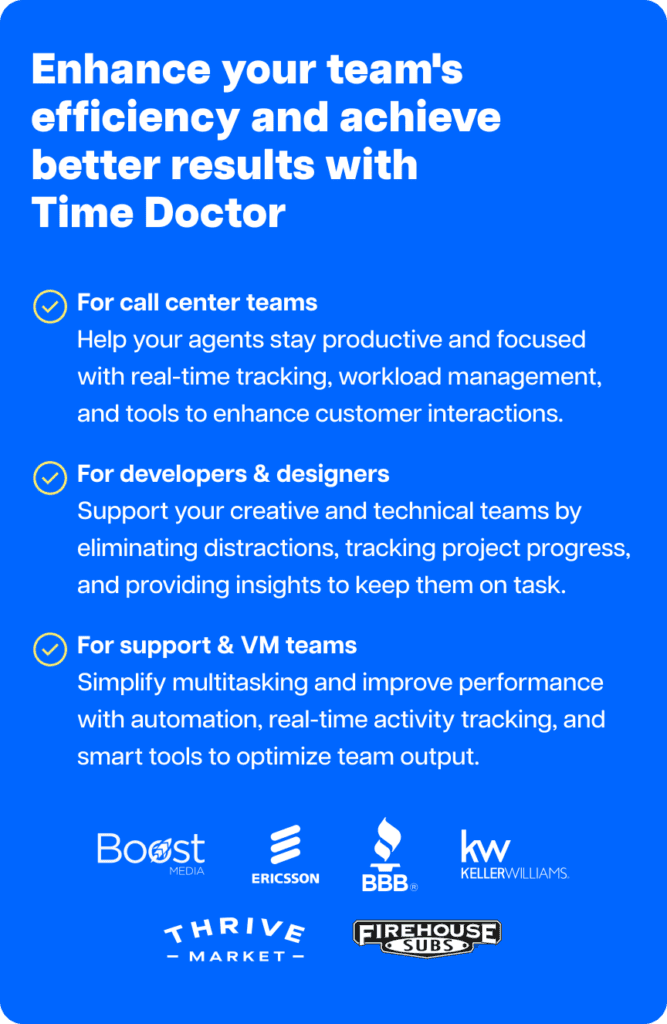Employee training and development is an important contributor to any company’s growth. Over the past few years, small and large businesses have started investing more and more in employee training.
This is because effective employee training leads to numerous benefits. Some of these benefits can be increased employee retention, employee satisfaction, increased productivity, and ultimately better ROI for the businesses.
In 2019, total global spending on employee training crossed $370.3 billion.

In the post-COVID-era, where all companies are going remote, it is important to pivot your old employee training methods. Onboarding and training your remote employees is not an easy task.
With no face to face connectivity, it can get difficult to train your remote employee, if you don’t have the right tools.
If you are looking for futuristic tools for remote training so that your employees are empowered with the right knowledge and skills, then this is the guide you have been looking for!
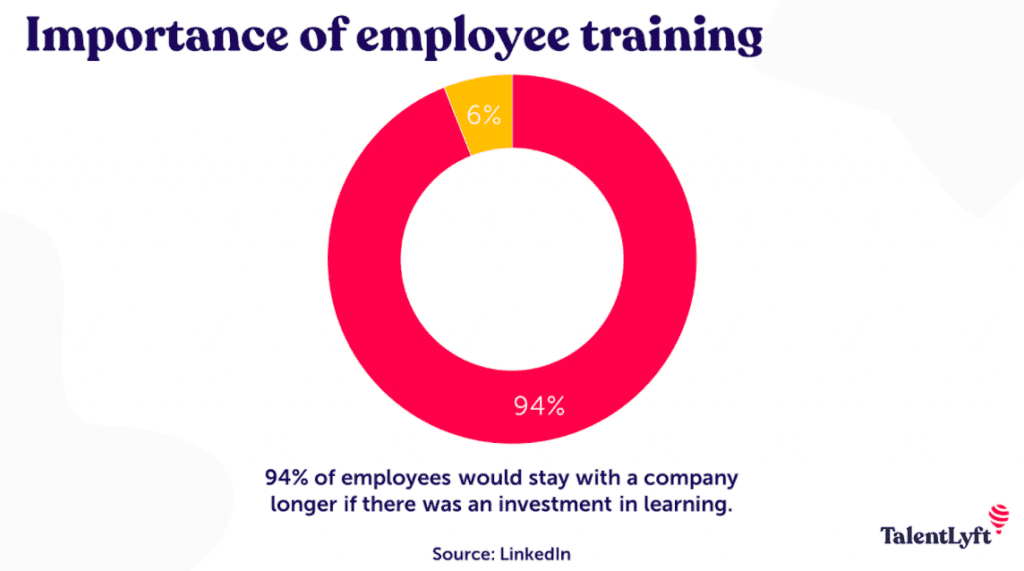
In this guide, we will dive deep and understand various industry trends and tools needed for remote training of your workforce. You’ll also gain insights into some effective strategies to train your remote employees with ease.
9 remote training and development tools to train your workforce
As your company evolves, it is important that your training methods also evolve. Employee expectations have increased over the years. And, empowering them with the right training tools is the best way to get the most ROI out of your remote workforce.
1. Zoom – Video conferencing

Sometimes, training documentation and pre-recorded videos may not be the best solution for remote employee training.
There will definitely be times when you will feel the need for having virtual instructor-led training or live sessions with employees. For such situations, video conferencing solutions such as Zoom are a must-have!
In a remote workplace, employees often get disconnected and frustrated as they feel lost. This is because there is an absence of face-to-face interactions with colleagues, groups lunches, water-cooler connects, etc.
Having face-to-face interactions once in a while is essential to establish this often missing personal connection with your remote employees. Having video conferencing and live chat tools like Zoom will bridge the gap between your and your employees.
Such video collaboration is very beneficial during the employee onboarding process. It is also essential for brainstorming sessions and while introducing new projects.
Zoom also has other additional features such as screen sharing, remote control of desktops, text chats, exchange of files, and broadcast groups.
2. WalkMe – Digital Adoption Platform (DAP)

Employee training can give mind-blowing results such as increased employee productivity and increased engagement. It also helps new employees to integrate better and faster with your company culture. But, all of this holds true only when you have optimized your employee training process.
Traditional employee training methods are both expensive and time-consuming. Moreover, most of the things that employees learn through such traditional learning methods are forgotten by them. Hence, businesses must adopt digital solutions that are best suited for remote employees.
Employee training, at its best, should be goal-oriented, agile, adaptable, digitized, modern, and should have employees’ best interests in mind. For attaining all of these, a digital adoption platform is a necessity.
An employee training tool such as WalkMe can give your employees a top-notch digital training experience.
WalkMe can help you automate quite a few parts of your employee training process. This in turn results in decreased training time, increased employee satisfaction, and improvement in employee retention rate.
With WalkMe, you can train your employees through comprehensive in-app training by designing customized guidance workflows. You can provide real-time training and support to improve knowledge retention, give task-specific training, and provide options for on-demand review.
All these features will help you to encourage employee self-service and ultimately shorten overall training time and increase productivity.
3. Slack – Remote employee communication

Employee training and development are not just restricted to instructor-led teachings, group training sessions, and in-app guidance. In a traditional setting, employees’ growth and development also involves communication with peers and superiors.
Such interactions lead to a meaningful exchange of information and experiences that help with employee development. Also, when employees are stuck at some point in a traditional office setting, it is easy for them to ask questions to their colleagues.
Unfortunately, such in-person interactions are not possible while working remotely. But, with the evolution of communication tools such as Slack, your employees can undergo the same experiences even in a remote setting.
Using Slack, you can encourage employee communication that benefits the employees’ growth. You can also create a Slack channel to regularly interact and host video-chats related to your training and development initiatives.
Such interactions will encourage employees to learn and interact more. It will also increase employees’ accountability towards your learning initiatives.
Slack also has additional remote-workspace-friendly features such as document sharing, screen-sharing, company-wide announcements, communications within departments, one-on-one direct messaging, and collaborative learning.
Hence, you must consider getting slack for your employees if you are struggling to encourage your employees to learn and grow more.
Stewart Dunlop, Founder of PPCGenius says “I would suggest using the Slack tool for communication between your teams. It allows team members to manage day-to-day communications and move through projects whether they are sharing a desk or a nation away from each other”
4. Trello – Track training progress

The use of project management tools such as Trello is not just limited to project management. In fact, you can get a lot of use out of Trello when used for employee training management!
Trello can be extremely useful for your company’s employee training initiatives. This is because using Trello, you can effectively manage your remote training process on a common portal.
You can break down employee training into smaller tasks and assign these tasks to employees using Trello. You can also assess employees’ training and collaborate with them for group training sessions.
Using Trello for tracking employees’ training can be super-helpful because it will help you track their progress and encourage a collaborative environment even while working in a remote setting.
Using a project management tool such as Trello will also motivate your employees to learn and train in new skills quickly. Assigning training tasks through this tool will also make your employees accountable for the investment that you are putting into their learning and development.
Jake Smith, Managing Director of Absolute Reg says “Trello is a useful and simple tool that I use for tracking the training progress of my teams”
5. iSpring – eLearning toolkit and learning management system
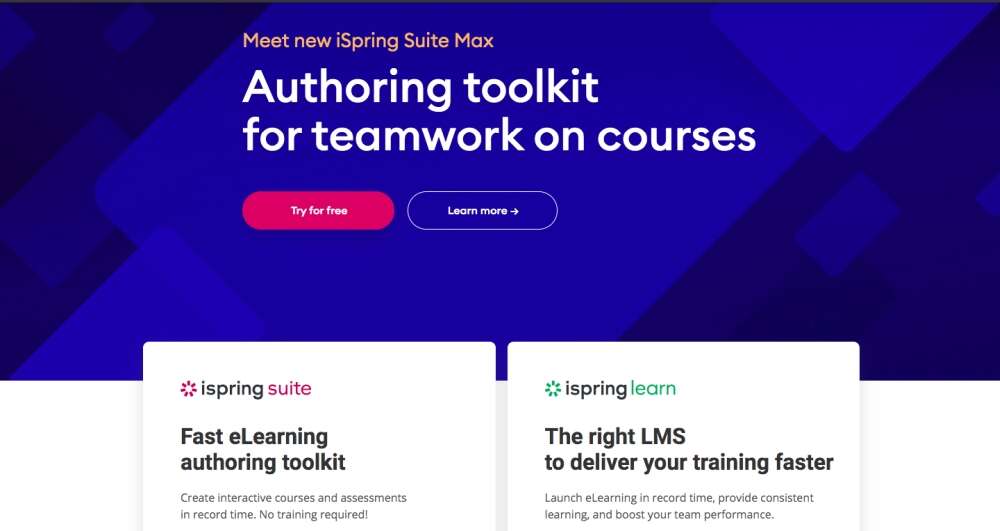
If you are looking for a tool that can help you create interactive courses and assessments for your remote employees, then you must try iSpring.
The iSpring learning toolkit helps you create scenario-based courses, assessments, software tutorials, and mobile learning courses. The tool is extremely flexible and allows you to create fun, interactive learning experiences for your employees.
Using the iSpring learning toolkit, you can create quizzes, role-plays, and video lessons with the help of their massive assets and templates content library. Using the tool, your employees can also collaborate as a team and go through different courses, all while working remotely.
The best part about iSpring is the ability to record and edit videos with absolute ease so as to create the best pre-recorded video-based lessons for your employees.
You can also get the iSpring LMS tool for launching your courses and boost overall team performance. The cloud-based LMS provides easy Zoom integration for live learning sessions, group chats, and screen sharing.
Using iSpring LMS, you can launch and manage onboarding training, product training, sales, training, compliance training, channel training, and certifications. You can even generate comprehensive reports on your employees’ performance and training progress.
6. Google Workspace (formerly G Suite) – Collaboration

Google Workspace, formerly known as G Suite, is a set of collaboration and productivity tools created by Google. Many major enterprises have already been using Google Workspace for years. And, if you haven’t already adopted, it is time for you to join the bandwagon too.
Google Workspace is one of the best productivity suites out there, but how can it help you with remote employee training and development?
The remote training process can involve storing and sharing confidential files. Google Workspace can help your employees store and share different learning materials on the cloud.
Even during the process of creating training documentation and ppts, more than one person might need to make changes in the same file. Google Workspace can be useful for such scenarios as well.
Using Google Workspace productivity tools, your employees can create learning content in the forms of documents, presentations, spreadsheets, and more. You can also create assessments for employees using the Google Workspace Forms.
The suite also helps you to securely store all your learning materials using Google drive. Moreover, Google Workspace comes along with additional connectivity tools as well. These include Gmail and Google Meet to ensure that your employees stay well connected throughout their training process.
Using Google Workspace, you can manage users, devices, and security settings. Plus, its monthly subscription comes at a super-affordable price. Hence, Google Workspace is one of the must-have tools for the efficient remote training and development of your employees.
7. Degreed – Learning portal

Degreed is another innovative learning and skill-development tool that can help you run large scale employee training programs with ease. It is an enterprise training portal that allows you to get a bird’s eye view of your company’s existing skill sets.
Based on the analytics of your organization’s overall skillsets, Degreed allows you to upskill or reskill your entire remote workforce. You can create custom learning programs for your employees, and provide useful insights for easy engagement, collaboration, and contribution.
Degreed takes it one step further by providing you with real-time analytics on the skill sets of your employees. Employees can thus learn and grow in the area that interests them the most. You can then view employees’ skill sets and map them to projects and opportunities that need those exact skill sets.
You might sometimes find that your employees are lacking in a certain area or skill. For such situations, you can create custom training for those skills, assign it to your employees, and ensure that you are effectively upskilling your remote employees.
Degreed helps you create training content pathways consisting of guides, links, videos, courses, documents, and similar more. Your employees can then take up these content pathways and become proficient in the particular skill set by the end of it.
Degreed also offers multi-language support and skill certifications. Hence, if you are looking for a powerful remote learning and upskilling tool for your company, then you must definitely consider getting the Degreed tool.
8. BizLibrary – Online training library
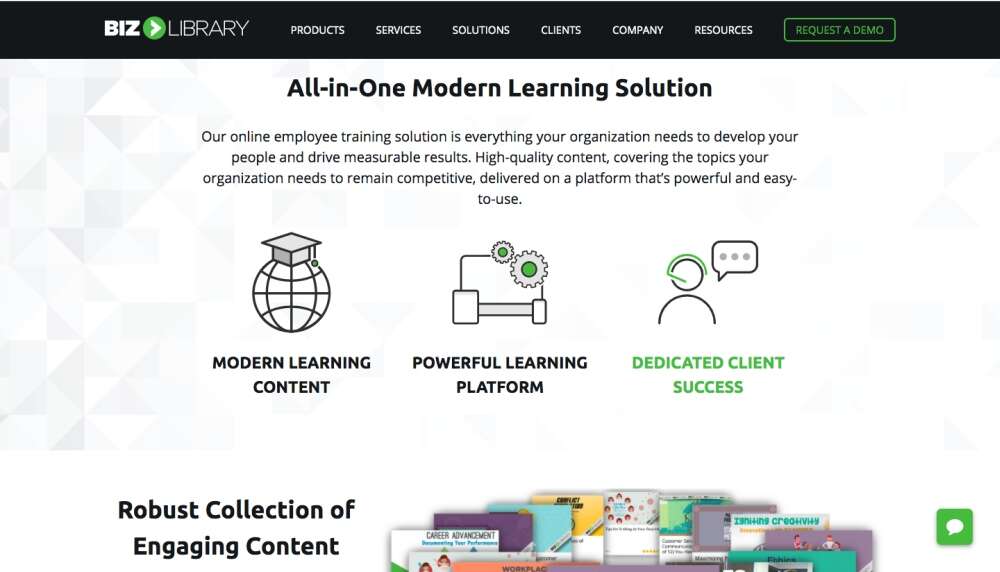
The BizLibrary tool consists of a massive library of online training resources covering a wide range of topics that your employees need to grow more efficient and competitive. The library consists of over 6000+ high-quality video lessons that will easily resonate with any corporate employee today.
The BizLibrary contains video lessons on much-needed topics related to business skills, soft skills, and even industry-specific topics. You can find an extensive library on courses related to leadership and management, HR skills, software skills, information technology, workplace safety, and sales.
All these training content has been created and curated by industry experts. The platform is mobile-friendly and thus resonates well with remote employees as they can opt for on-demand training whenever they like.
The BizLibrary platform also helps you manage compliance needs and assess the employees’ remote training progress. On top of that, you also get your own client success manager who will ensure that all your training and development goals are achieved as planned.
BizLibrary can save you months of creating and curating training content for your employees. Hence, you must opt for BizLibrary if you are looking for comprehensive training solutions that will encourage a learning environment amongst your employees.
9. Zoho ShowTime – Online training platform
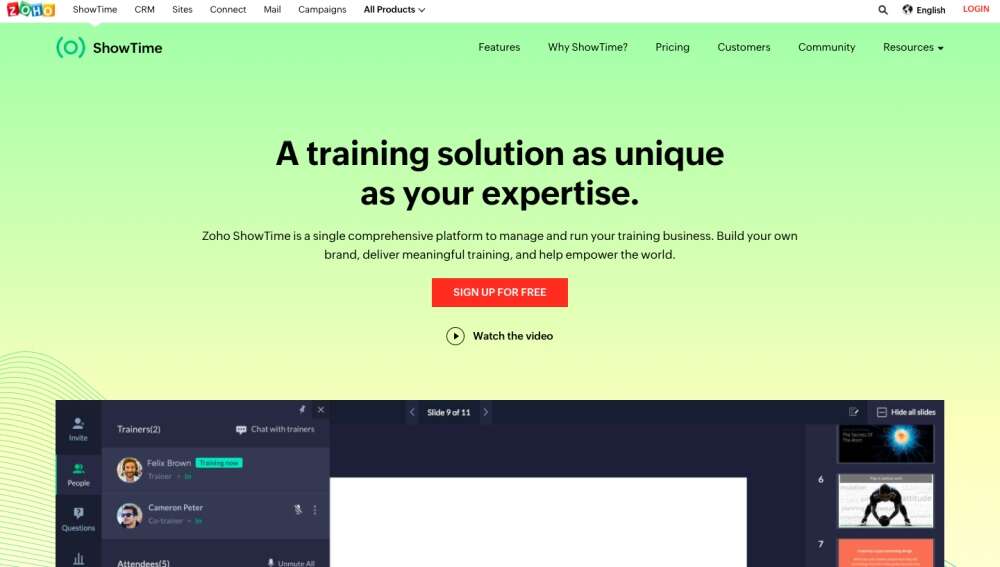
Zoho ShowTime is an online training solution that helps you manage and run your employee training programs. You can create and run onboarding training, product training, sales training, etc using this tool.
Using Zoho ShowTime, you can offer on-demand training and self-paced courses to your employees. This training may be of varied types based on your needs such as videos, presentations, documents, or any other forms of learning content.
Often, whiteboard training that involves drawing and explaining things to train employees can be missed when employees are connecting from their homes. Such shortcomings can be overcome using the whiteboard and virtual classroom feature of Zoho ShowTime.
You can provide an almost-real face-to-face experience to your remote employees with features such as screen sharing, polls, Q&A sessions, whiteboards, and similar more.
Zoho ShowTime has advanced features to manage your organization’s competencies and streamline responsibilities to enable the best possible virtual training and development experience for your employees.
Additionally, the Zoho ShowTime tool also enables you to customize all your courses, training, and virtual classroom sessions. You can also track and analyze the results using analytics provided by the tool.
Using Zoho ShowTime, you can analyze your employees’ engagement with various training modules and methods. This way, you can find which training style works best for your employees and stick with it to generate the maximum employee satisfaction.
Daniel Foley, CEO of Daniel Foley Marketing Agency says “Being a CMO at my company, I use Zoho ShowTime to virtually train my employees. This tool also offers an in-app chat whereby my employees can ask any queries during the meeting with ease. It also allows me and other trainers to share their screens with the trainees during the learning”
Tips to train your remote employees

By now, you must have a fair idea about all the necessary tools that you need for the remote training and development. Now, let’s look at some effective steps and strategies that can help you get the best results from your employee training programs.
1. Assess the current level of your employees
Before empowering your employees with powerful tools for training and development, it is highly recommended that you make a thorough company-wide assessment of current employee skills-sets.
Such an assessment will help you understand the areas where your employees are lagging. Using these insights, you can then strategize and plan your training accordingly.
You can identify the gaps in the current skill sets of your employees and then stress more on them. This will save you a lot of time and money.
2. Understand the needs of your employees
Apart from your assessment, it is also highly crucial that you understand the employees’ needs. After all, remote training should be designed to equip your employees with the best possible resources. Hence, it is important to understand their point of view.
You can conduct surveys, or interview employees to gather information on what are the areas and skill sets that they want to be trained at. This will immensely help improve your employee retention rates as they will know that you have their best interests in mind.
3. Set goals
Creating training and development content without goals will ultimately be a waste of time. With specific goals and objectives, you’ll know exactly what you want to achieve after a considerable time-period of training employees.
Your goals can be anything that contributes to the betterment of your company. Some examples can be increased employee retention rates, better customer satisfaction index, lesser customer complaints, increased revenue, better brand reputation, and similar ones.
3. Enable self-paced learning
Each of your employees will prefer different work times, especially when they are working remotely. With a remote work environment, flexibility is super-important. Hence, you should provide the option of on-demand training to your employees.
Enabling self-paced learning will help employees to learn whenever and wherever they want to, thus improving their learning pace and satisfaction.
4. Track employees’ training progress
Tracking employees’ training progress is essential if you want to achieve the maximum ROI out of your training and development programs. By tracking their training progress, you will be motivating your employees to learn and grow more. It also increases accountability. For accountability there are remote training tools like Trainual which integrate with time tracking apps like Time Doctor. Using these apps, remote employees can track the time they invest in training.
4. Encourage a collaborative learning experience
Learning is always fun when done in groups. Especially because, in remote settings, only learning through video lessons and courses may turn monotonous. Ultimately, your employees will lose interest in courses.
Hence, you should also organize group video conferencing sessions and team-learning programs to motivate your employees to learn more. This will also ensure that their overall training experience becomes more fun and they will look forward to learning more.
5. Stress on continuous growth and learning
Often the excitement of training dies down after the employee onboarding process. Employees get so caught up in work that they forget to learn more and upgrade their skills.
Hence, as a company, it is your responsibility to encourage an environment that stresses continuous growth and development. You must ensure that apart from working, your employees also continually learn and stay up-to-date with the latest industry trends.
6. Collect employee feedback and act upon them
For gaining the maximum amount of employee satisfaction, it is essential to know their views and opinions about your remote training programs. Hence, conduct surveys or one-on-one interviews to gather comprehensive feedback on your training content and methods.
Collect the data and look for any common patterns. For instance, most of your employees may feel that your training programs lack courses and training in a certain area. You can then update your training content accordingly. This will ultimately be profitable for your organization.
7. Ensure that your training materials are mobile-friendly
Lastly, this is a point that needs to be stressed. Most people prefer mobile-friendly training course materials because it provides them with the flexibility and ease to learn whenever they want to.
By ensuring mobile-friendly training solutions, you are removing a major obstacle from their training progress. This will motivate your employees to learn more and contribute to the betterment of your company.
Conclusion
With more and more companies going remote, many innovative and futuristic tools have come up that can help you train your remote employees.
Investing in new-age training tools such as productivity suites, digital adoption platforms, LMS, and communication tools can help you survive in this competitive world with the help of your remote workforce.
Using such remote training tools, you can develop a culture of continual and collaborative learning. So, take this wise step today and watch your business soar.
Author The Author –

Gaurav Belani is a senior SEO and content marketing analyst at Growfusely, a content marketing agency that specializes in content and data-driven SEO. With more than seven years of experience in digital marketing, his articles have been featured in popular online publications related to EdTech, Business, Startups, and many more.

